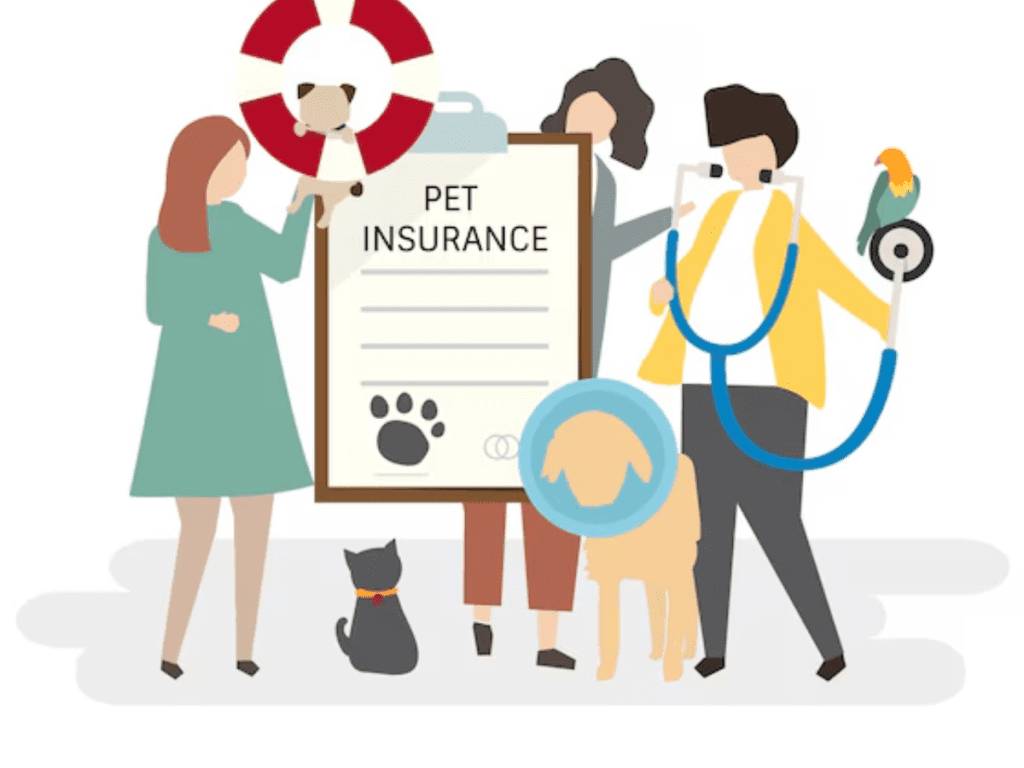Introduction
For many pet owners, their furry, feathered, or scaly companions are not just pets but beloved family members. Whichever it might be, like a playful dog, a curious cat, or even a little pet such as a rabbit or guinea pig, we need to make sure they get the best care that can be availed. Well, just as humans do, pets get ill, have chronic conditions, and sometimes experience accidents that require them to seek emergency medical care.
Veterinary expenses often run very high, creating financial burdens at times. Illness treatments, surgeries, or other emergency treatments can amount to hundreds or even thousands of dollars and put pet owners in a tight spot. Pet insurance is an immunity safety net to manage these sudden veterinary costs so that your pet receives necessary care without becoming a strain on you.
Understanding Pet Insurance: What Is It and How Does It Work?
Pet insurance can be considered an animal-specific version of health care insurance. Generally, it covers expenses the way human health care does. What pet owners will do is that they pay an extra monthly premium or annual insurance and the said company pays them for some services on veterinary expenditures. It includes various types depending on the packages that could encompass accidents, sickness, preventive maintenance, and also alternative therapies.
Most pet insurance plans require owners to pay the veterinary bill upfront and then file a claim for reimbursement. The reimbursement amount depends on the policy, deductible, and coverage percentage. Some insurance providers also offer direct billing to veterinarians, reducing out-of-pocket expenses.
Many pet owners underestimate veterinary care costs until it happens to them. A regular checkup and vaccination could be relatively inexpensive, but a surgery, chronic illness treatment, or specialized care could become very pricey. Here are some critical reasons why pet insurance is so important:
1. Protect Yourself from Crisis Medical Expenses
A sudden illness or injury can lead to costly medical procedures. Pet insurance ensures that you do not have to choose between your pet’s health and your financial stability. It allows you to focus on getting the best care for your pet without worrying about the expense.
2. Coverage for Expensive Surgeries and Treatments
Certain medical procedures may range from several thousands of dollars for orthopedic surgeries and cancer treatments up to emergency operations. In that regard, pet insurance helps bring these costs down and provide adequate care for the pet without financially burdening their owners.
3. Emergency and Critical Care
They just happen, sometimes in the car, sometimes poisoning, or maybe an injury from another animal. Emergency treatments, surgeries, and overnight hospital stays can be expensive. Pet insurance can cover much of these expenses, so the pet owner may not hesitate in seeking immediate medical help.
4. Access to Specialized and Advanced Treatments
The advancement in veterinary medicine has already provided treatments such as chemotherapy, laser therapy, physical therapy, and even alternative treatments like acupuncture and hydrotherapy. In the same way, pet insurance allows owners to afford cutting-edge treatments that improve a pet’s quality of life.
5. Routine and Preventive Care Coverage (Optional Plans)
Some insurance policies have what is termed add-on coverage for routine and preventive care including vaccination, an annual checkup, prevention of fleas and ticks, dental cleanings, and even spaying or neutering. Such coverage keeps pets healthy, and major illnesses are avoided before they occur.
6. Customizable Plans to Fit Your Pet’s Needs
Pet insurance firms have different covers available, from which pet owners can choose, according to a breed, age, and veterinary medical history for a pet. Whichever needs coverage, in-depth or mere accident and disease cover, are covered by them in accordance with requirements and personal budget.
7. Peace of Mind for Pet Owners
Most notably, this advantage is to make you free of worry: by knowing you’ll have backup finance in the case of medical emergency, it is easier for you to look to your pet’s recovery than stress over those high medical expenses.
Types of Pet Insurance Coverage
Depending on the kind of policy a provider offers, different plans generally fit into one of the categories described below.
1. Accident-Only Coverage This type of plan covers injuries resulting from accidents, such as fractures, poisoning, cuts, or ingestion of foreign objects. It is a budget-friendly option for pet owners who want protection against unexpected mishaps.
2. Accident and Illness Coverage
This is the most common type of pet insurance. It provides insurance coverage both for accidental injuries and illnesses, including infections, chronic diseases, cancer treatments, and hereditary conditions.
3. Comprehensive Coverage (Wellness + Accident + Illness)
Comprehensive plans include accident and illness coverage and preventive care, including vaccinations, annual checkups, flea control, and dental cleanings. These plans are more expensive in terms of premiums but will provide complete coverage for pets.
4. Custom Plans with Add-Ons
Some pet insurance companies allow personalization whereby the owner can add more coverage, such as alternative therapies, behavioral training, or specific breed-related conditions.
How to Select Your Ideal Pet Insurance Plan Ch
ose the best pet insurance policy after consideration of several factors: the coverage options; it should at least include essential treatments such as accidents, sicknesses, surgeries, and any form of preventive care if needed.
- Premium Costs: Compare premium amounts and choose a plan that fits your budget while offering sufficient coverage.
- Deductible and Reimbursement Rates: Check the deductible amount (the out-of-pocket expense before insurance starts covering costs) and the reimbursement percentage (how much the insurer will pay after the deductible).
- Exclusions and Limitations: Read the fine print to understand what is not covered, such as pre-existing conditions or breed-specific exclusions.
- Waiting Period: Some policies have a waiting period before coverage begins. Make sure you know when your pet will be eligible for coverage.
- Claim Process: Identify an insurer which has a straight forward claim procedure and quick times to reimbursement. Some providers are able to send payment directly to veterinarians reducing up-front outlays.
Common Pet Insurance Misconceptions
1. “Pet Insurance Is Too Pricey
Many people assume pet insurance is costly, but it is often more affordable than paying for a major surgery or emergency treatment out-of-pocket. With different plans available, pet owners can choose coverage that fits their budget.
2. “My Pet Is Healthy, So I Don’t Need Insurance”
Even healthy pets may still have accidents or become unwell suddenly. Having insurance means you are prepared for such accidents rather than dealing with financial hardship later.
3. “Pet Insurance Covers Everything”
While pet insurance provides great financial relief, it does not cover pre-existing conditions, cosmetic procedures, and other some experimental treatments. Knowing what your policy covers is very important.
4. “I Can Save Money Instead of Buying Insurance”
Saving money for pet expenses is a good idea, but an emergency can deplete that savings quickly. Insurance provides immediate financial support without draining personal savings.
Frequently Asked Questions About Pet Insurance
Many pet owners have asked questions about pet insurance, how it works, and whether it is worth the investment. Below are some of the most commonly asked questions and their answers.
1. Is Pet Insurance Worth It?
Yes, pet insurance is worth it, especially if you want to protect yourself from unexpected veterinary expenses. Even if your pet is healthy now, accidents or illnesses can occur at any time, leading to high medical costs. Pet insurance provides financial security and ensures your pet gets the necessary treatment without delay.
2. What Is Not Covered by Pet Insurance?
Most pet insurance policies do not cover:
- Pre-existing conditions (health issues your pet had before coverage began)
- Elective procedures (such as ear cropping, tail docking, or cosmetic surgeries)
- Breeding-related costs (pregnancy and delivery care)
- Experimental treatments
- Routine care (unless included in a wellness plan add-on)
You must read your policy carefully to understand what is excluded.
3. How Much Does Pet Insurance Cost?
Pet insurance cost varies depending on several factors such as:
- Breed : Some breeds are more prone to health issues and thus may have higher premiums.
- Age : Older pets usually have higher premiums.
- Coverage Level (Comprehensive plans with wellness care cost more than accident-only plans.)
- Location (Veterinary costs vary by region, affecting insurance premiums.)
Average pet insurance cost is between $20 and $50 per month for dogs and $10 to $30 per month for cats. Exotic pet insurance varies depending on the species and coverage level.
4. Can I Get Pet Insurance for Older Pets?
Yes, but the premiums are more expensive for older pets, and some policies even have an age limit. Additionally, some policies do not include coverage of old age diseases. However, you should get a policy as early as possible as the veterinary care cost rises with age.
5. How Do I Make a Claim?
The process of making a claim differs from one insurance company to another, but generally, the following steps are followed:
1. Visit the Veterinarian – Get the necessary treatment for your pet.
2. Pay the Bill – In most cases, you pay upfront and then file a claim.
3. Submit a Claim – Provide the insurance company with invoices and medical records.
4. Get Reimbursed – Depending on your policy, you’ll receive reimbursement for covered expenses.
Some insurance companies work directly with vets, allowing for direct payments instead of reimbursement.
Final Thoughts: Why Every Pet Owner Should Consider Pet Insurance
Pet insurance gives you peace of mind, knowing that you can give your pet the best medical care without financial stress. Whether it is an accident, illness, or ongoing medical condition, having coverage means you can make decisions based on what is best for your pet rather than worrying about the cost.
Investing in pet insurance is a responsible choice that not only protects your pet’s health but also safeguards your financial well-being. No one wants to be in a position where they have to choose between their pet’s life and their savings. By enrolling in pet insurance, you’re ensuring that your furry, feathered, or scaly friend gets the care they need when they need it the most.
If you never thought about such insurance for a pet, start now. Those small monthly premia can surely make a major difference in unexpected situations, therefore giving you ample freedom to put your pet best in the same care.

